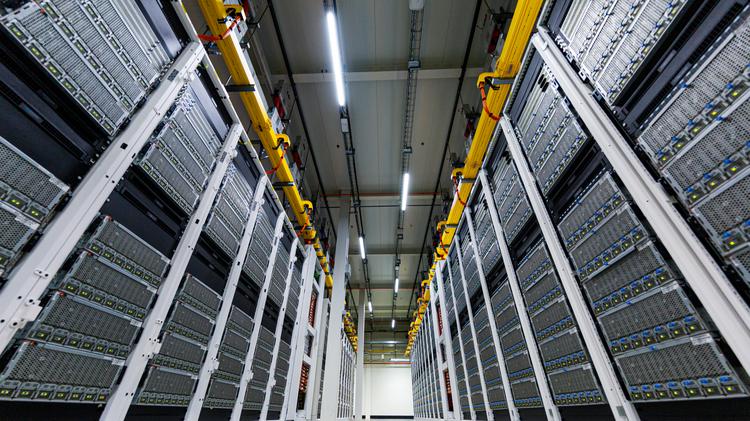Microsoft agrees to make data centers air cooled amid water infrastructure challenges in Goodyear

Redmond, Washington-based tech giant Microsoft Corp. has agreed to switch its cooling system for future data centers in Goodyear and invest more than $40 million to expand the city’s wastewater capacity through an updated development agreement that the city that was approved last week.
Microsoft has been planning to build a five-building data center campus across nearly 300 acres south of MC 85 and the Phoenix Goodyear Airport since it first purchased the site in 2018. It has been working with the city for several years to find a solution for the significant amount of wastewater produced from cooling its data centers — all as it continues to build-out its campus in phases.
Microsoft has developed a 290,000-square-foot building, has almost completed a 250,000-square-foot facility and wants to build another 250,000-square-foot building in the near future, but the city doesn’t have enough sewer line or wastewater plant capacity to take on more of its wastewater.
Through the updated agreement, which was unanimously approved on March 6 by Council, the company will pay $36 million for the estimated $90 million expansion of the city’s 157th Avenue Wastewater Treatment Plant. The payment will replace and reimburse wastewater impact fees for Microsoft and allow the company to use 1.2 million gallons of capacity per day at the plant at full build-out, city documents said.
The company will also deposit $5 million as a “financial assurance” for the cost of a new sewer line as well as $800,000 for a city representative to coordinate and facilitate development of the company’s data centers in Goodyear.
Microsoft originally planned to use direct evaporative cooling, or water cooling, for its entire campus, which would require 1 million gallons of water or a maximum of 5 million gallons per day delivered to the site. But its plans have since changed because of the quality of water delivered to Microsoft that would require additional costs and treatment to reuse. Now, Microsoft’s fourth and fifth buildings are required to use air cooling, while its first three buildings can continue to use water cooling by recirculating, or looping its water two times.
The Phoenix metro has become a landing spot for data center growth in recent years but has also caused contention in some Valley cities due to noise and water use. Microsoft is also developing a data center project across a nearly 150-acre site it purchased in 2019 near Citrus and Indian School roads.
Agreement could signify more permanent infrastructure solution for Microsoft
The update marks the third change to the infrastructure agreement between Goodyear and Microsoft and could serve as a more permanent solution for the company’s wastewater compared to the incremental approach that was previously implemented.
“From the initial agreement, the infrastructure development agreement that we entered into in 2019, we always contemplated that we would come back with an amendment that would comprehensively address all of the infrastructure that’s needed for a campus build-out,” said Cameron Carter, a Rose Law Group attorney representing Microsoft, at the March 6 meeting, adding that each building represents a more than $300 million investment.
In 2019, Microsoft first agreed to treat its wastewater so that the city could reuse it as potable water, or drinking water, but the quality of water Microsoft was receiving made this impossible, the city said. As a temporary solution, the city has allowed Microsoft to send up to 500,000 gallons of wastewater per day through its existing sewer line to Goodyear’s 157th Avenue Wastewater Treatment Plant.
But a city report said the existing transmission line that Microsoft is using was designed and sized to support development adjacent to the line and “was never intended to take industrial discharges from Microsoft’s operations,” resulting in a need for more water lines as Microsoft expands.
Microsoft had also agreed to construct treatment facilities that would limit the amount of total dissolved solids (TDS) like salt or minerals in the water and to control the amount of wastewater being sent to the existing sewer line, but these plans were also not completed because the company was working with the city on a potential brine solution that has not been finalized. Using water cooling would also be difficult because of the high levels of TDS in the water delivered to Microsoft.
“Only the first three buildings on that site will be water-cooled, they’re going to convert to air-cooled buildings after this third building,” said deputy city attorney Sarah Chilton at the Council meeting. “Part of that is, as it turns out the water that we’re able to deliver has high levels of TDS and it would just be cost prohibitive to recycle and take additional water supplies needed to treat it so that the TDS level was reduced.”
Microsoft has until Aug. 31, 2024 to complete the construction of a dedicated discharge line to deliver wastewater from its data centers to the plant.
“That’s when we anticipate other users are going to come online,” Chilton said.
Infrastructure in some West Valley cities have struggled to keep up with the growth of the area, leading to some wastewater capacity challenges for heavy-water using industries like food and beverage manufacturers. Recently, the city of Surprise agreed to take on 500,000 gallons of wastewater per day from Rauch North America Inc.’s Red Bull plant for Epcor Water (USA) Inc., the utility provider for the plant.
Since last year, Rauch and other beverage makers in the Glendale area have looked for solutions for limited wastewater capacity by utilities and to lower water and infrastructure costs. Nestle is currently supporting an Arizona Senate bill that would allow it to store and recycle its own wastewater as opposed to working with Epcor as a potential solution.
